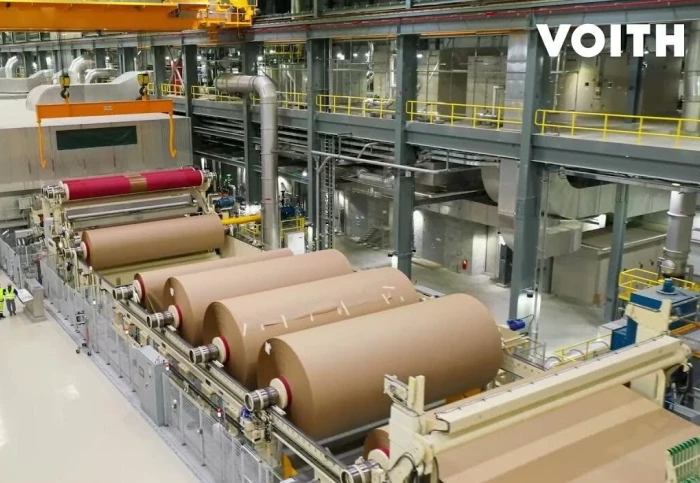An ELCA of Containerboard Manufacture in North American Pulp and Paper Mills


Luke Reid, an MEng student in Mechanical Engineering, describes his experience in exploring the sustainability of containerboard production
During my summer working at a management consulting firm in 2022, I witnessed how the rising pressure from consumers and regulators is forcing companies to consider sustainability not just as a moral obligation, but as a strategic imperative. During this time, I became particularly interested in how sustainability was evaluated, and on returning to university and Mechanical Engineering, I was keen to shift my focus from a commercial outlook towards a more quantitative and technical exploration of sustainability.
When the time came to choosing a final year project, I chose to conduct an industry focussed Life Cycle Assessment for my final year project supervised by Prof. Peter Lindstedt and Daniel Greenblatt. My goal was to use LCA methodologies to uncover quantitative and scientific results that could guide an industry towards more sustainable decision making. The pulp and paper industry is one of the largest and most energy-intensive sectors of the global economy. 2021 saw total paper production reach a record peak of 415 million air-dried-tonnes (ADT) (1) emitting more than 190 million tonnes of CO2 (1), consuming enough energy to power all global freight (8.6 million GJ) (2), and contributing to 14% of all global municipal solid waste (3).
Packaging is the fastest-growing sector of the paper industry with the most popular form being cardboard, a rigid and light packaging solution made by laminating sheets of containerboard with a corrugated fluting medium. In 2021, 170 million ADT of containerboard was manufactured, a figure estimated to rise to 200 million by 2032 (4). North America is a leading producer of containerboard with a market share of between 17-24% and an estimated annual production of between 30 and 50 million ADT in 2021 (4,5). Due to abundant forestry opportunities and lagging regulatory pressure, North America exhibits a distinctively lower capacity for recycled containerboard and a much lower average recycled content compared to its global competitors. However, this raises the question of the environmental opportunity cost associated with recycled and non-recycled containerboard. To meet aggressive targets required for the Net Zero by 2050 scenario (6), the IEA (2) predict that emissions and annual energy intensities in paper production are required to fall by 4% and 1.5% respectively between 2021 and 2030 (1). Highlighting the need to inform industry of the energy-saving potentials and environmental impacts of different production methods.
And so, for my project I conducted a Life Cycle Assessment (LCA) of the containerboard industry with the aim of evaluating of the energy and environmental impact of the two prevalent methods of containerboard manufacture in North America: the Kraft process and the recycled fibre process (RCF). The Kraft process is the conventional method of containerboard production that involves chemically pulping wood fibres to create virgin paper. Wood logs are debarked, chipped, and subjected to high temperatures and pressures in the presence of chemicals to separate the cellulose fibres. These fibres are then formed into paper sheets, dried, and processed into containerboard with waste being sent to a recovery boiler for chemical and energy recovery. The RCF process, in contrast, relies on reclaimed paper as its raw material. Wastepaper is collected, sorted, and processed to remove impurities, inks, and coatings. The fibres are then pulped and processed similarly to the Kraft method but without significant recovery technology.
Results showed that the average RCF process consumed 60% less total energy than the average Kraft process, with energy demand estimates of 9,200 MJ/ADT and 22,800 MJ/ADT, respectively. A contribution analysis highlighted the sensitivity of the RCF process to the papermaking stage and the overwhelming sensitivity of the Kraft process to the extent and efficiency of chemical and energy recovery. These sensitivities emphasised the need for mill specific comparisons. For example, when recovery rates were high, Kraft mills became energetically favourable and could recover enough energy to be net exporters of heat and electricity. The environmental impact assessment (EIA) was conducted using the ReCiPe2016 method implemented by the leading LCA software SimaPro. Results demonstrated that the RCF process caused less damage across all endpoint indicators. When scaled to a typical mill producing 500,000 ADT of containerboard per year, implementing RCF over Kraft processes would contribute 454 DALYs less damage to human health, preserve 1.97 species.yr of ecosystem damage, and save $23 million in future mineral and fossil resource extraction.
Despite struggling with data availability and visibility into SimaPro’s “black box” processes, my project offers a framework for further research on how to best integrate sustainability into the future of the containerboard industry. As well as quantifying the energy and environmental opportunity cost between recycled and non-recycled containerboard. Moving forward, I hope to use the knowledge and skills I have developed in this project to be an advocate for LCA methodologies. LCAs have the potential to provide un-biased and quantitative results which can help guide businesses and industries towards better informed, more sustainable decisions.
References
- IEA. Pulp and Paper. https://www.iea.org/reports/pulp-and-paper [Accessed 13.11.22]
- IEA. International Shipping. https://www.iea.org/reports/international-shipping [Accessed 23.05.23]
- Kaza S, Yao LC, Bhada-Tata P, Van Woerden F. What a Waste 2.0: A Global Snapshot of Solid Waste Management to 2050. Washington DC. World Bank. 2018. http://hdl.handle.net/10986/30317
- Naaz S, Shadab M. Containerboard Market Analysis- Global Supply & Demand Analysis & Opportunity Outlook 2023-2033. Research Nester. Report Number: 4507. 2023 https://www.researchnester.com/reports/containerboard-market/4507
- Sharp S. Containerboard (and Its Future) https://www.fisheri.com/blog/5-interesting-facts- about-containerboard-and-its-future [Accessed 06.11.22]
- IEA. Net Zero by 2050, https://www.iea.org/reports/net-zero-by-2050 [Accessed 26.05.23]
Article text (excluding photos or graphics) © Imperial College London.
Photos and graphics subject to third party copyright used with permission or © Imperial College London.